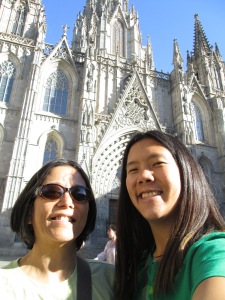We started off the day by checking out the Museu Picasso. It was the vision of Jaume Sabartés, Picasso’s longtime friend and secretary, to provide a means to display the many paintings, drawings, and prints that he had acquired through the years. Although the original intent was to found the museum in Málaga, his birthplace, his strong ties with Barcelona made the city a far more suitable candidate.
I’m sure you are all well acquainted with Picasso, but I will provide you a brief background nonetheless. In 1881, He was the first-born child of Don José Ruiz y Blasco and María Picasso y López. His father was a professor of art at the school of crafts and curator for the local museum. We can chance his Ruiz ancestor back to the blood of minor aristocrats.
Don, his father, was a firm believer in traditional artistic training, requiring young Picasso to conduct a disciplined study of the masters and perfect his sketches by practicing from sculptures and nude models. Through the years, and with the urging of his father and uncle, Picasso ended up at the Royal Academy of San Fernando in 1898, the most famous art school in the country. However, he disliked the formality of classwork and quit soon thereafter.
He eventually made his first foray into Paris in 1900, and it was there, that he formed his own unique style, what we know as Cubism today. Cubism is a fairly abstract expression of art as it lacks formality and is disruptive and detached to the eye. It also has the capability of evoking a realistic spirit and raw emotion if one chooses to ponder the painting long enough. See my previous post on the Guernica for more guidance.
*No Photographs = No Pictures for this. 😦
Our next destination was the Barcelona Cathedral, a massive looming structure that originates from the 13th century with final finishes completed in the 15th century. It is the seat of the ArchBishop in Barcelona, and dedicated to the Patron Saint Eulalia of Barcelona.
Saint Eulalia suffered martyrdom at the hands of the Romans when they stripped her in a public square; it is said that a miraculous snowfall covered her nudity. They then subjected her to 13 tortures, the primary one involving putting her in a barrel with knives in it, and rolling her down the street. She was only 13.
Forgive me for my gory imagery, I have been trying to decipher the meaning of all these saints as I am exposed to them in my foray into religious architecture. I will admit, however, the dearth of Gothic architecture I’ve encountered these past few weeks may have been excessive.
The day was wrapped up with a leisurely walk down the infamous La Rambla, including a stop at the Mercat de La Boqueria.






